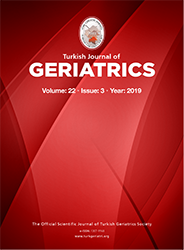Materials and Method: The study included 70 eyes of 35 healthy subjects in the control group and 60 eyes of 30 patients with chronic blepharitis. The patients were requested to complete a symptom questionnaire [Ocular surface disease index] before clinical examination. Non-contact meibography and non-invasive tear break-up time tests were performed with the Sirius Scheimpflug camera. Meibography scoring (Meiboscore) of the upper and lower lids was performed in all patients. Invasive tear break up time was performed 1 min after putting a single drop of fluorescein in all patients.
Results: The mean age of the patients was 74.6┬▒7.1 and 73.9┬▒6.3 years in the blepharitis and control groups, respectively (p = 0.669). The total meiboscore, non-invasive first and mean tear break up time, invasive tear break up time, and ocular surface disease index score were 3.6┬▒1.7, 8.0┬▒4.8, 9.7┬▒4.0, 7.1┬▒3.0, and 27.4┬▒11.7, respectively, for the blepharitis group and 3.0┬▒1.4, 10.4┬▒5.7, 11.4┬▒5.0, 8.6┬▒3.1, and 18.0┬▒6.4, respectively for the control group (respectively p = 0.03, 0.01, 0.03, 0.00, 0.00).
Conclusion: Chronic blepharitis in patients aged ?65 years was associated with morphological changes in meibomian gland, decreased tear break up time, and increased ocular surface disease index scores. In these patients, meibomian gland atrophy score is considered as a valuable method consistent with clinical findings.
Keywords : Blepharitis; Tears; Dry eye syndromes; Meibomian gland; Aged
